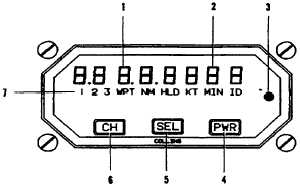TM 1-1510-225-10
3C-38
10. TACAN Indicator – Read range (NM).
Verify proper range is represented on
HSI distance readout.
11. If desired to proceed direct TO or
FROM a TACAN station, or determine
the course, rotate the course knob
until the course deviation bar is
centered and the TO/FROM pointer
indicates TO or FROM.
NOTE
Always crosscheck the HSI with the RMI
and other available navaids to determine
position.
12. To use TACAN with pilot-controlled
flight,
control
aircraft
by
manual
controls, responding to information
displayed on the flight director, RMI,
HSI, and other instruments.
13. To use TACAN with the autopilot,
press AP ENGAGE and monitor
autopilot
performance
on
flight
director, RMI, and TACAN indicators.
Verify adherence to preset heading
and course and confirm the execution
of displayed steering commands.
NOTE
The TACAN groundspeed reading will be
accurate only when the aircraft is on a
course directly to or from the TACAN
station. When headed away from the
station, the TACAN indicator minutes
reading will be in error.
(4) Shutdown. Turn VOL / ON / OFF knob –
OFF.
3C-23. DISTANCE
MEASURING
EQUIPMENT
(DME).
a. Introduction.
The
DME-42
receiver/
transmitter and IND-42A indicator can simultaneously
track and provide complete information from up to
three DME stations. The information displayed on the
IND-42A includes channel number (1, 2, or 3),
distance, groundspeed, time-to/from-station, and the
station identifier including the identifier of a DME co-
located with an ILS. Refer to Figure 3C-18.
Three-channel operation will have the DME-42
being controlled by both CTL -32 NAV Controls. These
provide serial digital commands to operate on 1, 2, or
3 specific frequencies through the single input port of
the DME-42. The DME channel 1 frequency will
always be the same as shown by the active frequency
display on the pilot's side CTL -32. The DME channel
2 frequency will always be the same as shown by the
active frequency display on the copilot's side CTL -32.
The channel 3 frequency is the same as shown by the
preset frequency display on the pilot's side CTL-32.
b. Controls,
Indicators,
and
Functions.
Except for audio, frequency selection and the self-test
switch, all operating controls for the DME system are
located on the IND-42A Indicator. Frequency selection
is accomplished using the CTL-32 NAV Control. The
DME-42 self-test routine can be initiated using the
TEST button on the CTL -32. DME audio is only
available for channels 1 and 2. When the DME audio
selector switch (pilot/copilot), located on the audio
control panel, is in the up position, DME audio is
available from either DME channel 1 or 2 as selected
by the DME AUDIO CHAN 1 / CHAN 2 toggle switch
located below the Data NAV control unit. Refer to
Figure 3C-18.
1. Numeric Display
2. Alphanumeric Display
3. Light Sensor
4. PWR Switch
5. Mode SEL Switch
6. CH (channel) Switch
7. Annunciators
Figure 3C-18. IND-42A DME Indicator
(1) Numeric Display – The numeric display
presents the NM (distance) and diagnostic code.
(2) Alphanumeric
Display
–
The
alphanumeric display presents the KT (Velocity) time-
to-station ID (2, 3, or 4 letter station identifier), and
diagnostic identifier.

